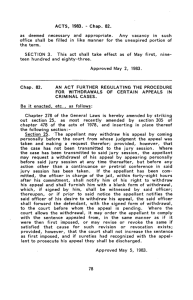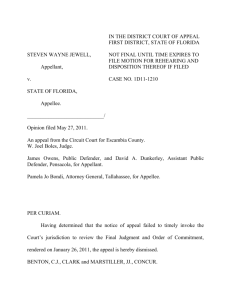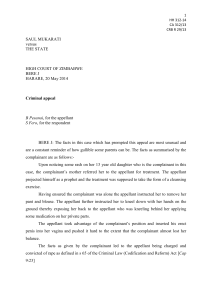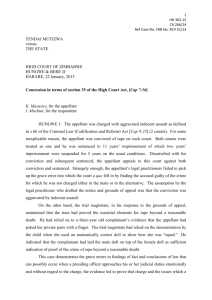PDF format
advertisement
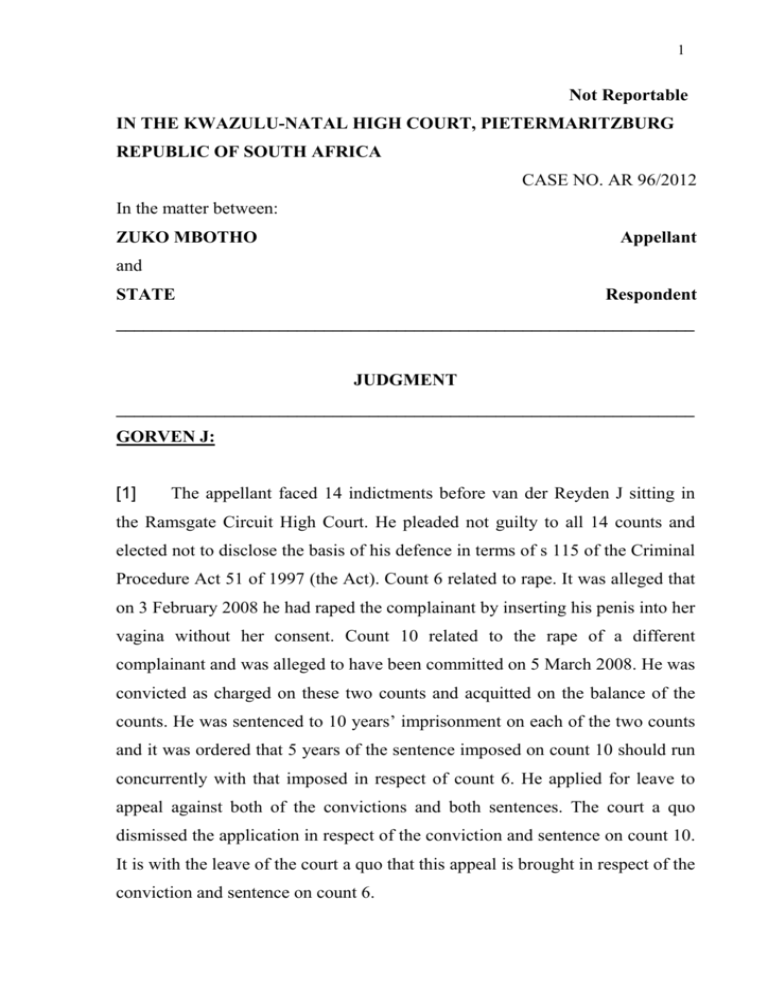
1 Not Reportable IN THE KWAZULU-NATAL HIGH COURT, PIETERMARITZBURG REPUBLIC OF SOUTH AFRICA CASE NO. AR 96/2012 In the matter between: ZUKO MBOTHO Appellant and STATE Respondent ________________________________________________________________ JUDGMENT ________________________________________________________________ GORVEN J: [1] The appellant faced 14 indictments before van der Reyden J sitting in the Ramsgate Circuit High Court. He pleaded not guilty to all 14 counts and elected not to disclose the basis of his defence in terms of s 115 of the Criminal Procedure Act 51 of 1997 (the Act). Count 6 related to rape. It was alleged that on 3 February 2008 he had raped the complainant by inserting his penis into her vagina without her consent. Count 10 related to the rape of a different complainant and was alleged to have been committed on 5 March 2008. He was convicted as charged on these two counts and acquitted on the balance of the counts. He was sentenced to 10 years’ imprisonment on each of the two counts and it was ordered that 5 years of the sentence imposed on count 10 should run concurrently with that imposed in respect of count 6. He applied for leave to appeal against both of the convictions and both sentences. The court a quo dismissed the application in respect of the conviction and sentence on count 10. It is with the leave of the court a quo that this appeal is brought in respect of the conviction and sentence on count 6. 2 [2] There is no doubt that the complainant was raped on the day in question. The attack on the conviction relates to whether or not the appellant was correctly identified as the person who had raped the complainant as she claimed. In this respect, the complainant was a single witness. There was therefore a two fold reason to exercise caution when evaluating whether or not to convict the appellant. The first was because the conviction relied on the evidence of a single witness. The second was because that evidence related to identification in circumstances where the complainant had never before seen her assailant. [3] As regards a single witness, the law is clear. The dictum of De Villiers JP in R v Mokoena1 was to the effect that the evidence of a single witness must be “clear and satisfactory in every material respect”. This has been somewhat corrected in S v Sauls and Others2 where Diemont JA said the following: ‘There is no rule of thumb test or formula to apply when it comes to a consideration of the credibility of the single witness (see the remarks of Rumpff JA in S v Webber 1971 (3) SA 754 (A) at 758). The trial Judge will weigh his evidence, will consider its merits and demerits and, having done so, will decide whether it is trustworthy and whether, despite the fact that there are shortcomings or defects or contradictions in the testimony, he is satisfied that the truth has been told. The cautionary rule referred to by De Villiers JP in 1932 may be a guide to a right decision but it does not mean "that the appeal must succeed if any criticism, however slender, of the witnesses’ evidence were well founded" … It has been said more than once that the exercise of caution must not be allowed to displace the exercise of common sense.’ 1 2 1932 OPD 79 at 80 1981 (3) SA 172 at 180E-G 3 [4] As regards identification, the cases are legion. The leading exposition of the approach to be taken is found in S v Mthetwa3 where Holmes JA said: ‘Because of the fallibility of human observation, evidence of identification is approached by the Courts with some caution. It is not enough for the identifying witness to be honest: the reliability of his observation must also be tested. This depends on various factors, such as lighting, visibility, and eyesight; the proximity of the witness; his opportunity for observation, both as to time and situation; the extent of his prior knowledge of the accused; the mobility of the scene; corroboration; suggestibility; the accused's face, voice, build, gait, and dress; the result of identification parades, if any; and, of course, the evidence by or on behalf of the accused. The list is not exhaustive. These factors, or such of them as are applicable in a particular case, are not individually decisive, but must be weighed one against the other, in the light of the totality of the evidence, and the probabilities….’ [5] The evidence of the complainant was simple. She had gone to a place to say goodbye to her boyfriend and was returning home along a road at about 3pm when she noticed a young man or boy following her from behind. He grabbed her neck and held her mouth while dragging her, struggling, into and area of bush until they were out of sight of passers by. It was because of his youth that she had been taken by surprise when he grabbed her and forced her into the bush. There he threatened her and removed her skirt. He instructed her to take off her T-shirt and to lie down, then removed her bra and raped her by placing his penis into her vagina whilst lying on top of her. She was a virgin at the time. When done with her he told her to crouch with her back to a tree, took her T-shirt and put it over her head and around her neck. He told her to open her mouth and put the bra in her mouth, tying her head to the tree with it. He tied her hands behind her back with his shoelaces. He tore her skirt, tied her body to the tree with it and left her there, telling her that he was going to retrieve her cellphone which had fallen when he grabbed her and dragged her 3 1972 (3) SA 766 (A) 768A-C. 4 into the bush. He then walked out of the bush in the direction from which they had approached. [6] After a while, she realised that he was not returning and managed to free herself. With her hands still tied behind her back, she grabbed her skirt and set off for help, coming to a shop whilst still naked. There she was assisted and the police and her parents were called. At about 4.30pm the police took her in their marked vehicle to look for her assailant. Whilst travelling along the road, she saw the appellant who was about 15 to 20 metres ahead. He was dressed as before and his takkies had no laces. The police vehicle began to stop. He turned around, saw the vehicle and ran from in front of the vehicle to behind it, disappearing into the bushes. A warning shot was fired and the police pursued him but he escaped. They then spoke to the appellant’s parent who undertook to contact the police when he returned. She then went to the police station and was taken to a doctor who found bruising of the labia minora, a fresh tear, swelling and bruising on her hymen, as well as a laceration on her left leg and an abrasion on her right wrist consistent with the wrists having been tied. The doctor concluded that rape and assault was probable. [7] After this they returned to the police station where a message was received from the parents of the appellant that he was at home. She, her mother and the police then went to his home. They were shown two young boys and she pointed out the appellant as being her assailant. He had changed his clothing by then and appeared frightened saying ‘Where did I see you?’ His parents said that his name was Zuko Mbotho. [8] She had about 15 minutes to observe him during the incident and did so closely. She could see his face at the time he was instructing her what to do, whilst he was raping her and was face to face with her, whilst he was tying her 5 up and preparing to do so and when he said he was going to fetch her cellphone and walked away. She described his clothing as being light blue shorts, a Tshirt which was whitish and a shirt which was Scots brown with cross-hatching stripes. She did not notice the colour of his takkies from which he removed the laces in order to tie her hands behind her back. It was daylight and he did not in any way cover his face or head. Her view of him was unimpeded. She described him as having a well built body but a young face and she estimated that he was about 14 years old. [9] When she saw him on the road whilst in the police vehicle, she claimed to have identified him by his face. It was no more than 1 ½ hours later. She also said that his clothing was unchanged. Significantly, she noticed that the laces were missing from his takkies. It was still daylight and she had an unimpeded view of him. She again identified him at his house as the person who had raped her and the person who had run away from the police earlier that afternoon. She strenuously denied that she had mistakenly identified the appellant as her assailant. [10] Her evidence as to what happened immediately after the rape was corroborated in every material respect by the shopkeeper and the police. Most significantly, Constable Zulu identified the appellant as the person who the complainant pointed out along the road. When he began to stop the vehicle and to call to the appellant, the latter ran away into the bush and escaped. He had good opportunity to observe him because the appellant turned towards the vehicle and passed the vehicle about 4 or 5 paces away when he ran towards the back of the vehicle. He was wearing blue shorts but Constable Zulu could not remember the other clothes he was wearing. When they returned to the van after the chase, the appellant’s grandmother emerged from her nearby property and told Constable Zulu that it was her son who had run away. She undertook 6 to contact the police when he returned. He saw the appellant soon after that day when conveying him from the juvenile centre to court. It was the same person who had run away on the day in question. [11] The version of the appellant is that he was herding goats that day in the company of three friends. He denied ever raping or coming across the complainant. He denied running away from the police. He denied having clothing of the type described by the complainant and Constable Zulu. He was fifteen at the time of the offence and seventeen when he testified. [12] The trial court found the complainant to be a good witness and was satisfied with her opportunity to identify the appellant and that she had done so accurately. It rejected the evidence of the appellant. The judgment was in extremely spare language and did not go into a great deal of detail. I am satisfied, however, that there were solid grounds for arriving at that conclusion and that the double need for caution was satisfied by the evidence for at least the reasons that follow. [13] First, the complainant had ample opportunity to observe the appellant and expressed herself surprised that a young person would accost and rape her. Secondly, the complainant described his clothing to the police before searching for her assailant, including the missing laces. Thirdly, the pair of shorts described by her was noticed by Constable Zulu when the complainant pointed out the appellant as her assailant. Fourthly, Constable Zulu corroborated her version that it was indeed the appellant who ran away when the police vehicle approached and as soon as the appellant saw it. Fifthly, the appellant’s grandmother identified him as the person who had run away from the police and this latter aspect was not challenged or dealt with at all in the evidence of the appellant. Nor did he challenge the fact that when he had arrived home, his 7 grandmother phoned the police as promised. Sixthly, the appellant was a young person who was fifteen years old at the time of the offence. Seventhly, Constable Zulu corroborates her version that the person who was arrested pursuant to the phone call from the grandmother was in fact the appellant. There is therefore no basis to set aside the conviction on appeal. [14] It is trite that an appeal court is only entitled to uphold an appeal against a sentence in limited circumstances.4 One of these is where the trial court has misdirected itself or where the sentence is so startlingly disproportionate that it induces a sense of shock. The trial court took into account the relevant factors and accorded them due weight. The only submission made in respect of sentence was that this court would be entitled to ameliorate the sentence on count 10 if the conviction on count 6 was set aside. I am of the respectful view that there are no misdirections warranting interference on appeal. Neither is the sentence at all disproportionate. There is therefore also no basis to interfere with the sentence on appeal. In the result the appeal against the conviction and sentence imposed on count 6 is dismissed. _________________________ GORVEN J _________________________ GYANDA J _________________________ MOODLEY J 4 S v Rabie 1975 (4) SA 855 at 857D-F. 8 Date of Hearing: 31 May 2013 Date of Judgment: 31 May 2013 For the Appellant: Z Anastasiou instructed by the Pietermaritzburg Justice Centre For the Respondent: J du Toit instructed by the Director of Public Prosecutions.
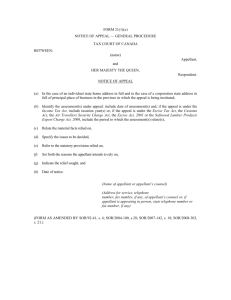

![[J-56A&B-2014][MO – Eakin, J.] IN THE SUPREME COURT OF](http://s3.studylib.net/store/data/008438149_1-ddd67f54580e54c004e3a347786df2e1-300x300.png)

